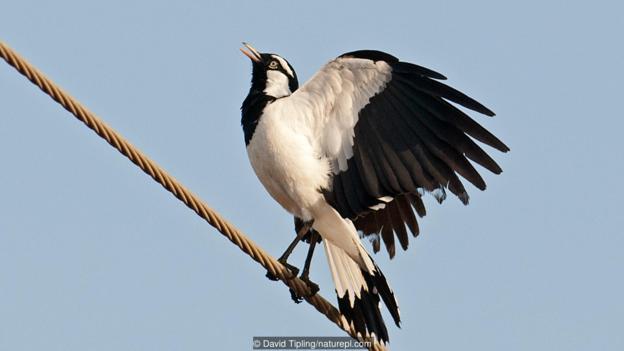(BBC) Echoing through the woodlands and back gardens of Australia, the haunting whistles of magpie-larks are not, to human ears, the most musical of bird songs.
The rhythmic "pee-wee-wit" calls of these distinctive black-and-white birds are actually duets, sung by couples to scare away intruders, rather than creative attempts by a male to serenade his female.
Yet what they lack in tuneful ability, it appears these feathered creatures may make up for with a different type of musical talent. They are the conductors of the avian world.
With a flare of their wings or flick of a tail, magpie-larks seem to mark time for each other during their songs, in much the same way as an orchestra's maestro flourishes their baton.
"Duets can be so precisely coordinated that partners sound like a single bird," says behavioural ecologist Paweł Ręk of the Australian National University in Canberra, who studies magpie-lark displays.
"When one bird sings, the other is silent. At the same time, movements are coordinated with songs, creating a complex but very coherent display. In the vast majority of duets, each bird sings one part, different to its partner, and performs one type of movement, the same as its partner."
When magpie-lark couples duet, one of them produces a short "pee-wee"-type call, which is then swiftly followed by a "wit" reply. This performance can go on for several seconds.
These duets are all about signalling to other magpie-larks.
Despite their name, magpie-larks are not closely related to magpies or larks. Instead, they belong to a family called the monarch flycatchers. They are highly territorial and mostly sing side-by-side during the breeding season, while they build their nests from wet mud and grass.
Ręk's colleague Robert Magrath, also at the Australian National University, showed in 2007 that the rhythmic vocal duets send a signal to other magpie-larks that the pair are a finely-tuned team, not to be messed with. In other words, if they can sing well together, they can also fight well together.
Magpie-larks are one of around 200 species of birds that duet like this. Yet unlike many of these other birds, magpie-larks also produce a strange visual duet at the same time. They simultaneously raise their wings, shrug their shoulders or flick their tails up in the air.
This physical element of the performance was baffling, because the magpie-larks did it even when rival birds were not within visual range.
In an attempt to unravel this, Ręk turned to robotics.
He took the skins of male and female magpie-larks, which he had found dead, and stuffed them with mechanical skeletons. He was able to programme these "robo-birds" to replicate some of the movements performed by the real birds during their duets, and to coordinate them.
Ręk placed his mechanical birds in the field and studied how 18 wild pairs of magpie-larks reacted. He either played only audio recordings of duets, only a visual duet by his robots, or the two combined. The reaction was almost instantaneous.
"When I turned the models on, a female magpie-lark came along together with a group of other birds, mainly noisy miners and Australian magpies, and they all together attacked my birds," says Ręk. "A fight ensued and my models tumbled down, two wings came off and were stolen by magpies. I didn't know whether to laugh or to cry."
However, once the robots were given new sets of wings, Ręk was able to discern a pattern.
While the wild birds reacted aggressively to the recorded songs, they appeared less bothered by the visual performances alone. This suggests the visual displays do not send any message to rival pairs.
Single magpie-larks sometimes try to cheat, performing both parts of the duet by themselves
Instead, Ręk suggests that it helps the couples coordinate their songs. The findings have been published in the journal Animal Behaviour
"We found it is very unlikely that birds choose their movements at random," says Ręk. "Magpie-larks learn to coordinate their songs, and pairs that have been together longer can sing better-coordinated duets than new pairs. Better-coordinated duets are better at keeping the intruder pairs at bay, because they signal a better, more experienced, pair."
More recent research, which has yet to be published, has found that single magpie-larks sometimes try to cheat, performing both parts of the duet by themselves. When they do this, they do not perform the visual side of the duet – in line with Ręk's idea that the gestures are for coordination.
Ręk says the findings suggest magpie-larks are among the most accomplished musicians in the animal kingdom.
"Compare this situation with a pair of musicians training together," says Ręk. "Apart from playing, musicians move their bodies, so that they play the role of conductors and musicians simultaneously. Even a conductor responds to players he directs, and such a feedback provides much better outcomes than following strictly-assigned roles."
Rufous-naped wrens may conduct in a similar way, says Dan Mennill of the University of Windsor in Canada, who was not involved in the magpie-wren research. In fact, the wrens may even conduct their own orchestras.
"They produce two-bird duets as well as three- or four-bird choruses," says Mennill. "We found that they produce head-bobbing displays, feather-erection displays, and tail-fanning displays in a coordinated fashion, just like these magpie-larks."
Mennill and his colleague David Bradley documented these behaviours in a study published in 2009.
"I expect that the use of visual dances to coordinate the duetting behaviour of birds may be more widespread than anyone has recognised," says Mennill.
Fuente: WWW.BBC.COM
